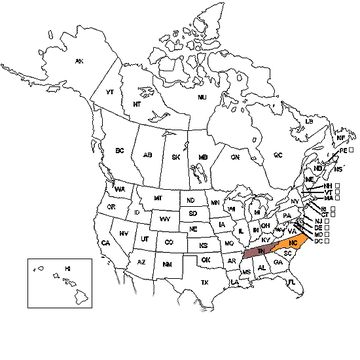
Habitat
The Mesodon altivagus is a terrestrial snail found in the Great Smoky Mountains in Tennessee and North Carolina. It's habitat consists of only one area of spruce-fir and northern hardwood forest above 1,500 meters on the highest summits of the Great Smoky Mountains. The trees found in the spruce-fir forest, Fraser Fir and Red Spruce, once covered much of the southern United States, but because of increased temperatures, the trees retreated into higher elevation. In 1980, the snails were so populated at Clingmans Dome, Tennessee that it was hard not to step on them after a rainfall (Florida Museum of Natural History, 2012).
Many factors have led to a decrease in the Mesodon altivagus population over the past 25 years including changed air quality, nutrient leaching, and loss of forest. The changed air quality affects the snails because of the acidic rain from the coal burning power plants and exhaust coming from cars that drift over the Smokies. The acidic rain reduces the calcium carbonate available to the snails for building their shells. The rain is also leading to a decrease in the Fraser Fir which is detrimental to the snails’ habitat (Florida Museum of Natural History, 2012).
In addition to acidic rain, a species of invasive insect, the balsam woolly adelgid (Adelges piceae) is killing many Fraser fir at Clingmans Dome. This insect was introduced on trees from Europe and the Fraser fir has little natural defense against it, making it even more susceptible to death (National Park Service, 2012).
 Map
of Mesodon altivagus distribution.
Map
of Mesodon altivagus distribution.
In North Carolina, the snails are found in two counties, Avery and Swain. The North Carolina Natural Heritage Program in 2008 listed the Mesodon altivagus as significantly rare in North Carolina and ranked it as S2S3 in North Carolina and G2G3 globally. Significantly rare means that it has not been listed as endangered, but only exists in small numbers and needs to be monitored by the N.C. Natural Heritage Program (LeGrand, et al., 2008).
The North Carolina rank of S2S3 indicates that there is a level of uncertainty whether this snail should be considered imperiled (S2) or vulnerable (S3). This rank estimates the extinction risk from information gathered over the past 30 years from the N.C. Natural Heritage Program, NatureServe, and many universities, government agencies, and other organizations. A rank of S2, or imperiled, indicates that the species is imperiled in North Carolina making them very vulnerable to extinction in the state because there are few remaining individuals (1,000 to 3,000). A rank of S3, or vulnerable, indicates that the species is vulnerable to extinction because it is rare or uncommon, or found in a restricted range, or due to other factors. With the level of uncertainty with the Mesodon altivagus ranking of S2S3, it is fair to assume that this species of snail has some degree of vulnerability of extinction in North Caroline due to low numbers of individuals, 1,000 to 3,000 is S2 and 3,000 to 10,000 in S3 (LeGrand, et al., 2008).
The global rank is assigned by NatureServe staff and contract biologists based on the status of a species throughout its range. A rank of G2 indicates that the species is imperiled globally with 1,000 to 3,000 species, 2,000 to 10,000 acres, or 10 to 50 linear miles. A rank of G3 indicates that the species is vulnerable globally because it is very rare throughout its range, found in only restricted areas, and typically has between 3,000 and 10,000 individuals. With the rank of G2G3, there is a level of uncertainty where the Mesodon altivagus should be ranked, but it is clear that it is vulnerable to extinction especially due to the restricted range it is found in. (LeGrand, et al., 2008).
Go to Adaptation!
Go Home!
